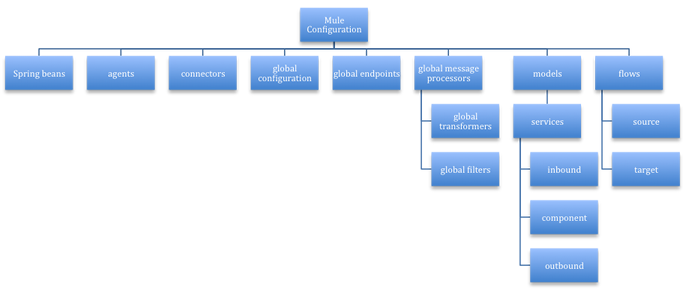
About Mule Configuration
| Mule Runtime Engine versions 3.5, 3.6, and 3.7 reached End of Life on or before January 25, 2020. For more information, contact your Customer Success Manager to determine how you can migrate to the latest Mule version. |
Following is an introduction to configuring Mule ESB via the Spring XML file. For details on this file, see About the XML Configuration File.
Overview of a Mule Configuration
A Mule ESB configuration file is a tree, as shown in the following illustration:

Each of these elements provides access to configuration objects within Mule:
-
Custom Message Processors - Observe a message, or modify either a message or the message flow. Examples include transformers and filters.
-
Flows - Use message processors to define message flow between a source and a target.
-
Mule Global Configuration - Global settings, such as the default transaction time-out, that apply to the entire Mule configuration
-
Connectors - Non-default configuration of any transports used
-
Endpoints - Define the channel and address or path where messages are sent or received. You can define them globally and use them in multiple flows.
-
Transformers - Convert data from one format to another. You can define them globally and use them in multiple flows.
-
Filters - Filter out the messages that don’t match specific criteria. You can define them globally and use them in multiple flows.
Following is an example of a simple Mule configuration file:
Simple Mule Configuration
<mule xmlns="http://www.mulesoft.org/schema/mule/core"
xmlns:xsi="http://www.w3.org/2001/XMLSchema-instance"
xmlns:vm="http://www.mulesoft.org/schema/mule/vm"
xsi:schemaLocation="
http://www.mulesoft.org/schema/mule/core http://www.mulesoft.org/schema/mule/core/3.0/mule.xsd
http://www.mulesoft.org/schema/mule/vm http://www.mulesoft.org/schema/mule/vm/3.0/mule-vm.xsd">
<vm:connector name="vmConnector" queueTimeout="5000"/>
<vm:endpoint name="CustomerRequests" path="customer.requests"/>
<vm:endpoint name="CustomerResponses" path="customer.responses"/>
<custom-transformer name="ThisToThat" class="com.acme.transformer.ThisToThat"/>
<flow name="myBasicFlow">
<inbound-endpoint ref="CustomerRequests"/>
<component class="com.acme.service.BasicService"/>
<outbound-endpoint ref="CustomerResponses" transformer-refs="ThisToThat"/>
</flow>
</mule>Other, more advanced things you may configure at this level:
-
Security Manager - Authenticates requests based on one or more security providers
-
Agents - Agents are typically used for cross-cutting concerns such as logging or management
-
Notifications - Allow you to be notified upon certain lifecycle events
-
Transaction Management - Mule transactions are configured on inbound endpoints, where an endpoint can be configured to start a new transaction or join an existing one.
-
Properties - Property placeholders, message properties, and system properties.
Global Configuration Settings
You can configure global configuration settings such as the default transaction timeout and default threading profile in the <configuration> element. For example:
<mule>
...
<configuration defaultTransactionTimeout="31337">
<default-threading-profile poolExhaustedAction="RUN"/>
...
</configuration>For a list of the available global configuration settings, see Global Settings Configuration Reference.
Accessing the Configuration Programmatically
All Mule configuration is accessible from a single object: org.mule.api.config.MuleConfiguration.
Configurations in a MuleConfiguration are set when a MuleContext is created. The object becomes immutable after it is started and can be accessed using the following:
// implement MuleContextAware to have the reference injected
MuleConfiguration configuration = context.getConfiguration();


